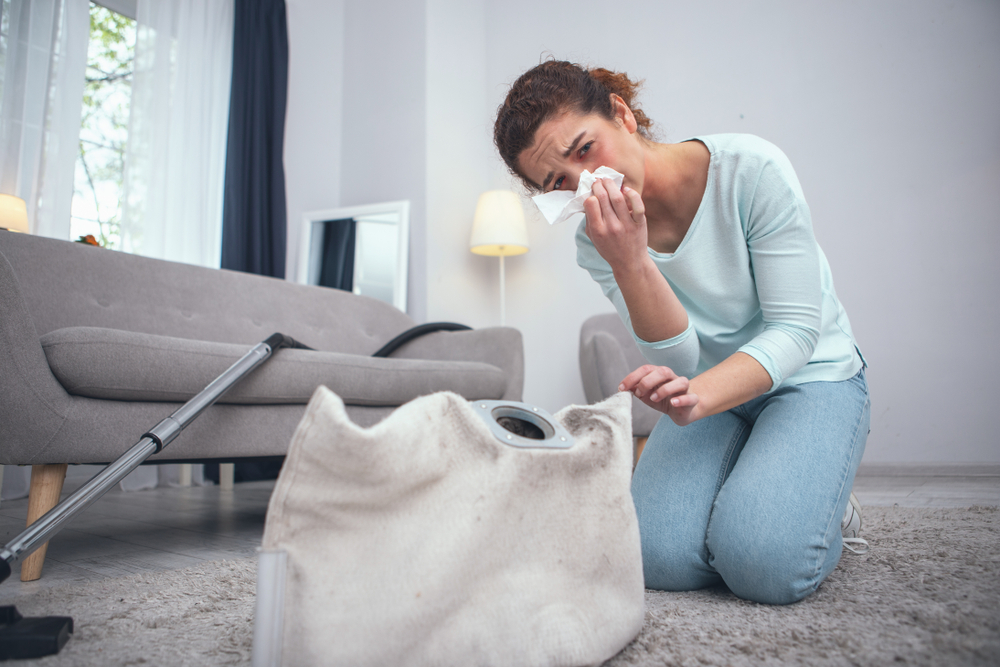Preventing Allergies with a Deep Carpet Clean

Why are Carpets a Problem for Allergies?
This might seem obvious, but it’s important to cover the basics.
Carpets are made of fabric, and regardless of whether it’s synthetic or natural fabric, they collect debris. That includes dirt, dust, and other particles. This is a problem for allergy sufferers because that means carpets also collect particles such as pollen or mold that can cause seasonal allergies.
And that’s just with carpet under normal use conditions. Carpeting that gets wet or suffers water damage can become a home for even more harmful forms of mold and mildew.
The main issue here is that unlike other fabrics like clothing or towels, carpeting will hold pollen and mold even after multiple vacuuming or cleaning cycles. These allergens can work their way deep into the carpet, making it nearly impossible to remove them.
Now, these carpet issues on their own don’t cause allergies more so than the particles or spores in the air. But they “ramp up” any reactions that you, your family, or your guests might have if they are sensitive to them. Worse, they can continue to cause problems even after allergy season is over, making residents of your house more susceptible to winter illness and congestion.
Does the Kind of Carpet I Have Matter for Allergies?
Yes and no.
- No, because carpet can hold on to pollen and other particles regardless of the material it is made of. Synthetic nylon carpet still has bristles that catch dirt from the air. Likewise, all carpets still have padding that can get wet and trap mold or mildew.
- Yes, because, depending on the material, you might find that the carpet attracts more allergy-causing debris. Wool carpeting, for example, is a much more hospitable material for mold and bacteria than nylon.
A few preventative measures you can take when picking out your carpet are the following:
- Buy nylon carpeting;
- Avoid shag carpeting and get a carpet with shorter strands; and
- Find carpets designated as Volatile Organic Compound (VOC); VOC carpets have little-to-no chemicals on them (like formaldehyde or benzene), which can trigger sensitive allergic systems.
A few minutes of planning and forethought can prevent allergy issues with your carpet.
DIY Carpet Cleaning Checklist for Allergy Prevention
The only real way to address allergens deep in carpet is with a professional deep cleaning. However, there are several DIY steps you can take at home that will help reduce the impact of these particles on your health by keeping them at bay for longer periods of time.
- Vacuum every day. This is especially the case if you live in a high-allergy part of the country like South Carolina. Try to find a vacuum that specializes in pulling out particles from the carpet, and make sure that the vacuum uses a HEPA filter. Also, ensure that the filter is clean.
- Spot clean stains as they happen. Stains can draw bacteria or mold, especially if they are food-related.
- Use an allergy-rated air purifier. These purifiers can pull harmful pollen or mold out of the air before they even land on your carpet, mitigating the need to do deep carpet cleaning on a regular basis.
- Keep your pets clean and brushed. Shedding pets are going to be a problem for allergies no matter what, but if you keep them brushed with a proper pet brush, give them regular baths, and clean up and vacuum regularly, then you can lessen some of that impact.
While these aren’t replacements for deep cleaning, they are the kinds of preventative measures that can reduce the frequency of deep carpet cleaning while making your home more comfortable for those with allergies.
Professional Deep Carpet Cleaning to Remove Allergens
Even with all that daily preventative work, you’ll still need to have the carpet deep cleaned. Allergy carpet cleaning, at a minimum, requires some sort of steam or chemical agent to loosen and remove debris from deep within the carpet fibers. Steam cleaning, also known as the hot water extraction method, has been proven to reduce allergens in carpet. Even better, hot water can kill other problematic pests like dust mites. Most professional carpet cleaners will have a hot water extraction setup on their van. Some allergy sufferers claim that wet-cleaning methods could cause issues since dust mites and molds thrive in humid and warm conditions. In these cases, dry-clean methods are proposed as an alternative. However, the primary issue with steam cleaning is that it can be a problem when not done properly. For example, if someone doesn’t properly remove all the water from the carpet after a cleaning, there could possibly be issues related to moisture. In any case, you should probably avoid DIY methods for deep cleaning, if for no other reason than improper steam cleaning can cause more harm than good. It also helps avoid issues that come up with rental steam cleaners, which are often not cleaned properly and have been used at some of the dirtiest homes in your town.
Allergy Deep Cleaning Prevents Headaches
A combination of DIY prevention and deep cleaning are going to help your allergies this season. With a clean carpet, you can reduce the impact of pollen and mold in your home. Outside of regular cleaning, make sure that if any are of your carpeting suffers water damage that you get professional help immediately. Mold is increasingly becoming one of the most damaging allergens in our homes, and once it has taken root, it is hard to get rid of. If you have a trusted professional cleaner on speed dial and take the steps necessary to avoid common allergens, then your carpet should be as allergy-friendly as you can possibly make it.
